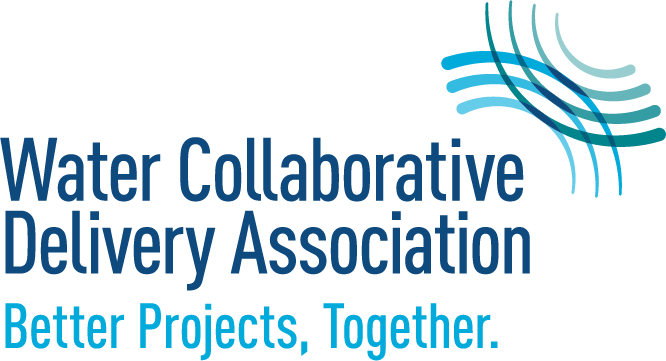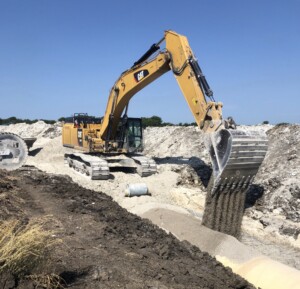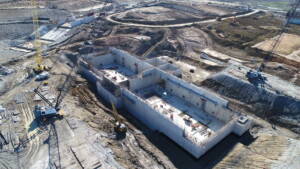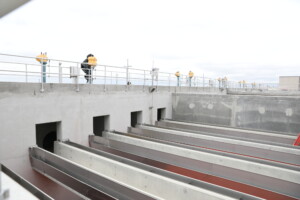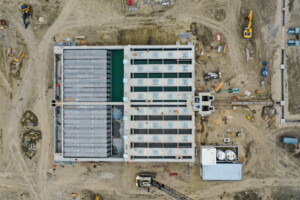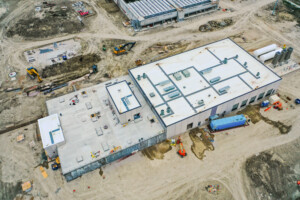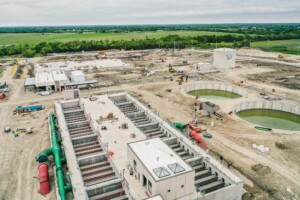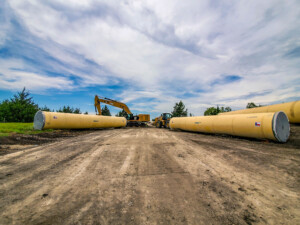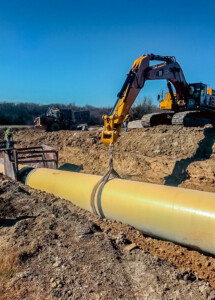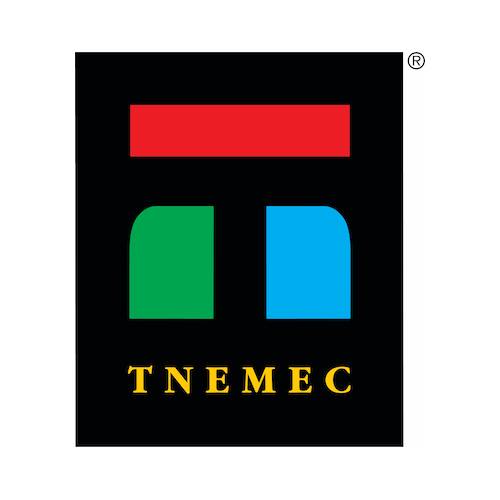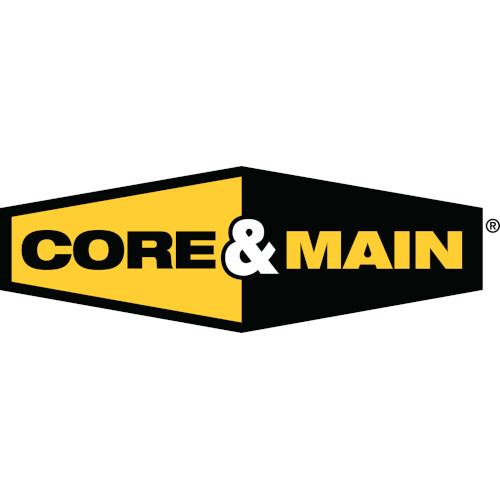Challenge
Bois d’Arc Lake is the first major reservoir constructed in Texas in nearly 30 years. After 15 years of planning and permitting, construction of the reservoir began in May 2018. Bois d’Arc Lake, located in Fannin County, is part of a $1.6 billion water delivery program to expand North Texas Municipal Water District’s (NTMWD) regional water system.
The project was a critical component in the region’s water supply plan to meet the growing demands of the area. In the last five years, the population of North Texas has increased by 650,000, which necessitated an upgrade to the region’s water facilities. Jacobs performed the master planning efforts for a 280 mgd greenfield water treatment plant and designed the first 70 mgd phase. There was an inherent risk with the uncertainty of the plant’s feed water quality from the new reservoir water source. To address this risk, Jacobs developed a reservoir model allowing a robust process design able to handle wide swings in raw water quality. Design of the 70 mgd initial plant included influent pumping, flocculation/sedimentation, ozonation, biological filtration, chlorine disinfection and clearwell storage facilities, as well as residuals management facilities. Jacobs is also providing a wide array of commissioning services for the new 70 mgd Leonard WTP.
Within this project’s five major project components, Garney was hired as the construction manager at-risk (CMAR) for two of the packages with design partners, including Black & Veatch. Black & Veatch provided design and construction administration services for approximately 10 miles of the raw water pipeline and several tunnels crossing railroads, rivers, and Texas Department of Transportation highways.
The first package consisted of constructing a raw water pump station (RWPS) located adjacent to the new reservoir, a water treatment plant (WTP), and a high-service pump station (HSPS) located in Leonard, Texas. The RWPS will initially move up to 90 million gallons per day (mgd) from the reservoir to the WTP. The Leonard WTP will initially be able to treat up to 70 mgd of raw water from the reservoir into drinking water for NTWMD customers. As one of several bid packages for the new WTP, this project provided structural, architectural, and process mechanical construction of the ozone contactor and the liquid oxygen (LOX) storage structure. As a subcontractor to Garney, Kiewit’s responsibilities included all earthwork, under- and above-ground piping, including underslab process piping, HVAC, plumbing, structural steel, cast-in-place concrete, roofing, precast buildings, miscellaneous metals, and testing and installation of all equipment.
The HSPS will initially be capable of moving up to 70 mgd of this drinking water from the WTP to its end users. Kiewit’s scope of work on this project included earthwork, installing 84-inch underslab and yard pipe, structural concrete (including 40-foot-high walls), miscellaneous metals, embeds, bridge crane installation, precast concrete, structural steel, and cast-in-place roof structure.
As a tier one subcontractor to Garney, Archer Western’s responsibilities included turnkey construction of the new RWPS. The pump station was constructed to accommodate a buildout of nine pumps and all associated appurtenances and equipment. The initial pump installation included three 2,700 HP, 50 mid pumps at 250’ TDH operating with AFDs. The RWPS also included a football-field-sized pump station 40 feet below ground, discharge pipeline, flow meter, pump and electrical building, and other infrastructure to support the pump station. Additionally, Archer Western constructed two clear wells, major excavation for the new HSPS, and 12 finished water filters for the new WTP.
The second package included the raw and treated water transmission pipelines. For this portion of work, Garney was the CMAR and self-performed a large portion of the work, including a 90-inch-diameter raw water pipeline from the RWPS to the WTP and the 84-inch-diameter treated water pipeline from the WTP to McKinney, Texas, to be distributed to the community. In total, Garney installed nearly 47 miles of pipe for this project.
Approach
The CMAR delivery method was an ideal selection for a project of this magnitude. By virtue of the sheer distance (approximately 60 miles), there were a multitude of challenges that varied along the course of the pipeline alignment. The northern portion of the raw water alignment is predominantly rural in nature, while the southern portion of the treated water alignment is more populated. Consequently, the diversity from one end of the project to the other posed many different and unique types of challenges. Having a competent and qualified CMAR contractor engaged early in the design aided not only in mitigating those challenges but also in facilitating advancement of design without sacrificing completion milestones.
Unlike the traditional design-bid-build (DBB) delivery method, the CMAR delivery method allows for participation during the design phase. Being a participant in the design phase empowers the CMAR to offer constructability suggestions, review public relations concerns, and develop initial construction sequencing of work. Furthermore, the CMAR is afforded the opportunity to procure long-lead materials as well as execute construction contracts prior to final design. Ultimately, this delivery method allows the CMAR to overcome many of the schedule and design constraints that are typical of the DBB delivery method.
Results
Throughout the course of this project, the team faced many challenges. Some of the most difficult included:
- Logistics: The biggest risk to the schedule was the logistics, as it spans over 60 miles. The entire raw water portion of the project is in Fannin County, which has a rich history of cotton farming but did not have the roads required for deliveries of all the materials. The CMAR worked strategically with the County to ensure roads were maintained and built. The round-trip turn times for pipe and aggregate hauling were three to four hours.
- Open Cut Installation Versus Tunneling: During the design phase, the CMAR team was able to walk the project site and provide constructability reviews. One of the most cost impactful suggestions the CMAR was able to provide was to remove multiple tunnels from the original design and complete them via open cut. Most of the locations were creeks that the CMAR understood could be timed to open cut in the summer months or had banks that could be restored properly.
- Public Safety: With the total project traversing nearly 60 miles, public safety was going to be paramount to the success of the project. The pipeline crosses multiple state highways, farm to market roads, and county roads. As work was being completed on each of these road crossings, communication with the community, notification to the proper commissioners and elected officials, and discussions with Texas Department of Transportation was required. The CMAR was able to ensure that the shutdowns did not impede or pose a risk to emergency service vehicles, school bus traffic, and the general public.
Despite many obstacles, the project team prevailed. The program is projected to meet the needs of North Texas’ growing population through 2040.
Other WCDA members involved: Ferguson Waterworks (supplier of pipe and fittings) and Core & Main (supplier of gate valves); Tnemec (supplier of high-performance protective coatings)
